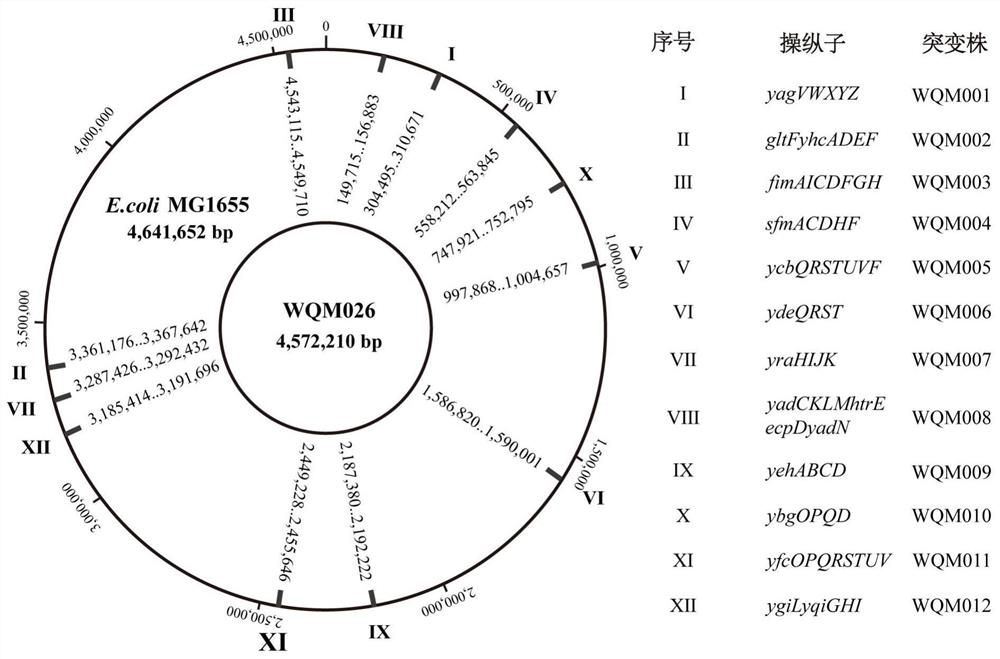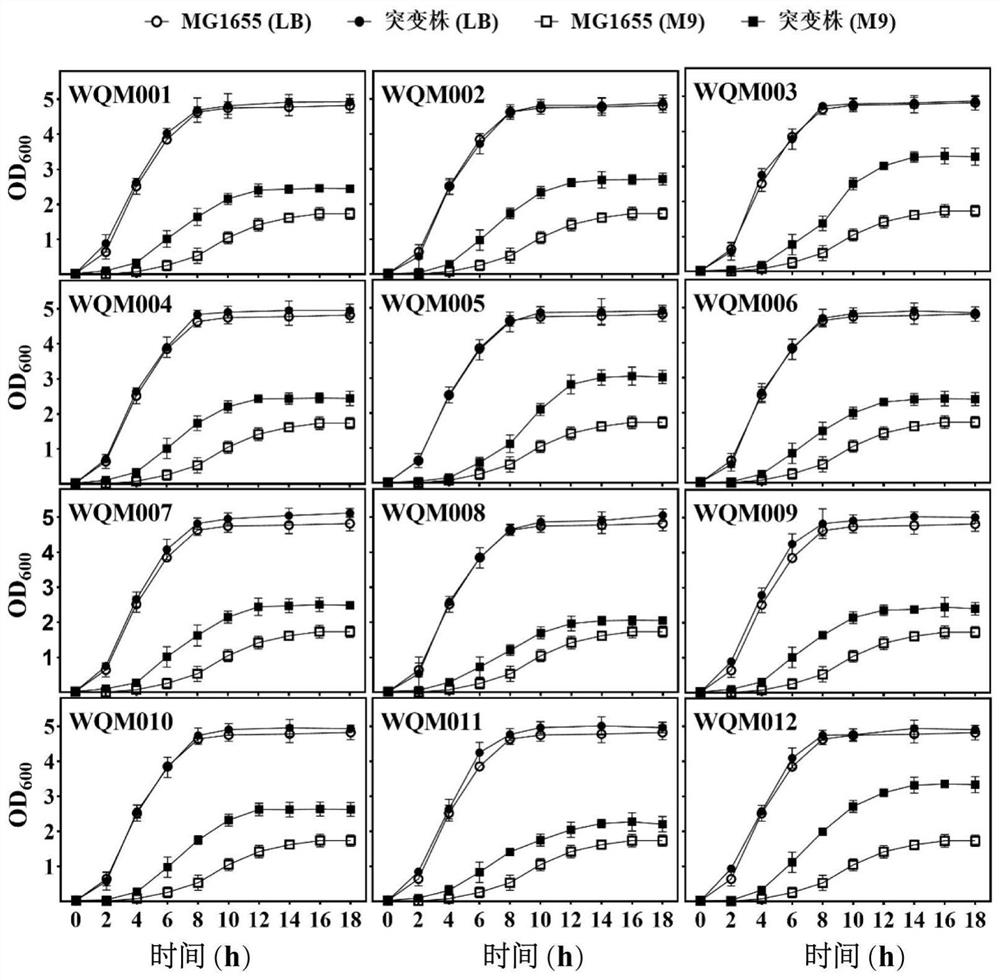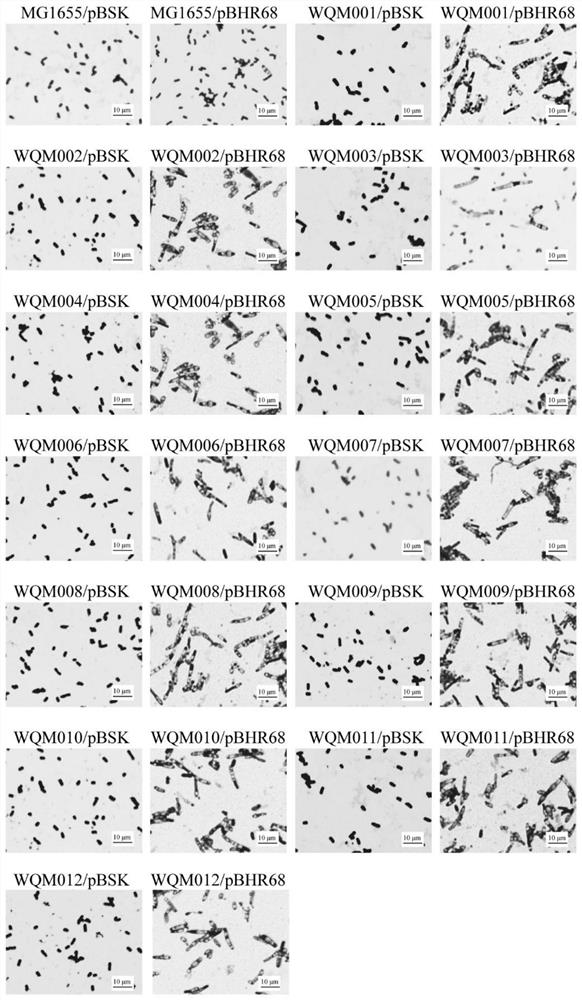Construction and application of fimbriae-free escherichia coli capable of improving production efficiency
A technology of Escherichia coli and recombinant Escherichia coli, applied in the fields of genetic engineering and fermentation engineering, can solve the problems of slow growth of L-threonine fermentation, consumption of large carbon sources, and inability to meet the requirements
- Summary
- Abstract
- Description
- Claims
- Application Information
AI Technical Summary
Problems solved by technology
Method used
Image
Examples
Embodiment 1
[0053] Example 1 Construction of Pili Deletion Engineering Bacteria
[0054] The specific construction process of pili-deficient engineering bacteria is as follows:
[0055] (1) Preparation of MG1655 / pCas competent cells:
[0056] Inoculated with Red recombinant helper plasmid pCas9 (Jiang, Y., Chen, B., Duan, C., Sun, B., Yang, J., Yang, S.2015.Multigene editing in the Escherichia coli genome via the CRISPR -Cas9 system. Appl EnvironMicrobiol, 81(7), 2506-14.) Escherichia coli MG1655, in LB liquid medium containing 100 μg / mL kanamycin, 30 ° C, 200 rpm overnight culture. Transfer to 100mL LB liquid medium according to 2% inoculum size, cultivate to OD at 30°C and 200rpm 600 When = 0.2, add L-arabinose (final concentration is 30mmol / L) to induce the expression of recombinase, continue to cultivate to OD 600=0.5, put the culture medium in an ice bath for half an hour, then transfer it to a pre-cooled 50mL centrifuge tube, centrifuge at 8000rpm at 4°C for 10min to collect the ...
Embodiment 2
[0069] Example 2 Knocking out a single pilus gene cluster promotes growth and PHB synthesis
[0070] Escherichia coli contains 12 gene clusters for the synthesis and assembly of pili ( figure 1 ). Pili not only increase the pathogenicity of bacteria, but also consume a large amount of energy and carbon sources during their synthesis and assembly. Therefore, in theory, removing these pili could improve the biosafety and production efficiency of E. coli.
[0071] Twelve pili synthesis and assembly gene clusters were removed from the chromosome of Escherichia coli MG1655 to obtain strains WQM001, WQM002, WQM003, WQM004, WQM005, WQM006, WQM007, WQM008, WQM009, WQM010, WQM011 and WQM012. These strains were cultured in LB and M9 medium, respectively. Detect the OD value of the bacterial solution every 2h and draw the growth curve of the bacterial strain, such as figure 2 Shown: In LB medium, the growth curves of all 12 mutants were similar to the control strain MG1655, indicati...
Embodiment 3
[0075] Example 3 Morphology and metabolite analysis of WQM026
[0076]As can be seen from the results of Example 2, the removal of each pilus synthesis and assembly gene cluster can promote the growth of E. coli cells and the biosynthesis of PHA, so all 12 pilus synthesis and assembly gene clusters on the E. coli MG1655 chromosome was deleted, thereby constructing the pili-deficient bacterial strain WQM026 (see Example 1 for the construction method). Detect the OD value of the bacterial solution every 2h and draw the growth curve of the bacterial strain, such as Figure 5 Shown in A: the growth of WQM026 in LB medium is slightly better than that of MG1655, and the growth in M9 medium is much better than that of MG1655. The OD value of WQM026 is about 3 times that of MG1655 when cultured to 18 hours. This suggests that removing all 12 pili gene clusters in E. coli benefits cell growth, especially in a nutrient-poor environment. Electron microscope observation of MG1655 and WQ...
PUM
 Login to View More
Login to View More Abstract
Description
Claims
Application Information
 Login to View More
Login to View More - R&D
- Intellectual Property
- Life Sciences
- Materials
- Tech Scout
- Unparalleled Data Quality
- Higher Quality Content
- 60% Fewer Hallucinations
Browse by: Latest US Patents, China's latest patents, Technical Efficacy Thesaurus, Application Domain, Technology Topic, Popular Technical Reports.
© 2025 PatSnap. All rights reserved.Legal|Privacy policy|Modern Slavery Act Transparency Statement|Sitemap|About US| Contact US: help@patsnap.com



